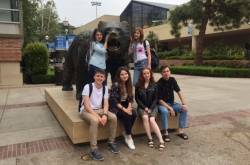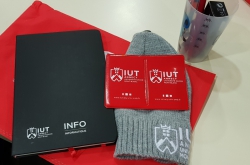ESIEE Paris is a French graduate school of engineering that was founded in 1904. According to a ranking by L'Etudiant, it is placed amongst the country’s top three in terms of academic excellence and first in connections with enterprises. Its key areas of focus are computer science, electrical engineering and communications, nanotechnologies, innovations management, and several others.
ITMO and ESIEE Paris are partner universities that conduct joint educational programs. Recently, six ESIEE students did an internship at the School of Translational Information Technologies and worked at the Institute of Design & Urban Studies. Upon arriving in Russia, the students chose the topics for their projects and split into groups. Later, they presented four projects in several areas: from data representation in virtual reality to emotion analysis in social networks.
Human-data interaction in virtual reality
Virtual reality gives us an opportunity to do things that we can’t do in real life. In the past years, the range of applications VR technologies has only been increasing, ranging from video games and entertainment industry to medicine and defense industry, where VR is used to create complex simulations. Virtual reality technologies have made their way into data management, as well. 3D visualization of data is already applied in such field as real estate, smart city technologies, and many others.
Emilien Ferrandi, a student from ESIEE Paris, believes that VR technologies are most promising in regards to data visualization. When represented in a 3D space, data can be organized in a more comfortable way and made a lot more comprehensible. Still, the application of VR in this field is not limited by just that.

“For now, this only looks like a different way of presenting data; users are pretty much unable to interact with or manage it. Still, there are lots of elements that we want to improve, says Emilien. Our project’s goal was to develop a more comfortable and interesting way of interacting with data.”
The students developed a program that represents data as physical objects that the users can “move” and interact with. Having put on a VR headset, they see a “custom workspace” with sets of data that they can move around. For instance, if you have a set of data about St. Petersburg, you can use it create a map of your own. In future, the program can be adapted for any kind of data, which will greatly increase its field of application. Emilien shared that working on this project was a novel and rewarding experience, although he plans to leave its future development to his colleagues.

“When I attended ITMO’s presentation at ESIEE Paris, I noted some of the university’s areas of proficiency that I wanted to learn more about. This internship was definitely a good experience. What is more, the project I worked on offered a great opportunity to work with virtual reality. This was what I’d been wanting to do in the past several years, but never got the time to. Still, I plan to focus on other projects from now on,” concludes Emilien Ferrandi.
Analyzing emotions in social networks
For the fourth year student Salahedine Abdelkrim, an internship at IMTO University became an opportunity to improve his skills in the field of data analysis and try working in a new field. During his time in St. Petersburg, he worked on a project on collecting and analysing data from Instagram and Twitter, with a focus on English language content. He developed a system that can sort data into three groups: information with negative, positive and neutral connotations.

“This has been my first experience of studying in Russia. I chose to study Computer Science at ITMO University, as it is quite famous in this field; many great data analysis specialists work at the School of Translational Information Technologies here. I worked on a project dedicated to data analysis in social networks. I believe that this topic is very interesting and promising. If your company knows how to analyze data, it will understand its target audience better. What was also important is that I was absolutely free to do what I wanted and could organize my work as I liked,” says the student.
In his free time, Salahedine and his friends watched the games of the 2018 World Cup and got to witness France’s triumphant victory over the Croatian team.
Two other ESIEE student teams also kept a close eye on the championship and even dedicated their projects to the topic of football. Jounaid Djoudi and Raouf Warnier studied the citizens’ and tourists’ emotions during this major event. Unlike their colleague, they also studied tweets in Russian. They were assisted by the staff at the QULLAB laboratory of the Institute of Design & Urban Studies.

The project’s authors chose and analyzed over ten thousand tweets in English and Russian, ranking them according to six categories: “joy”, “hope”, “love”, “sadness”, “anger” and “neutral”. The students came to the conclusion that the overall atmosphere of the event was cheerful and induced more positive than negative emotions. For instance, out of 2,365 tweets in English, only slightly more than 80 fell into the “anger” and “sadness” categories. What’s more, the students used the collected data to create an emotional map of the championship.
“We chose this topic for our project because our internship coincided with the World Cup in Russia, and we thought that it would be interesting to analyze the fans’ emotions. What is more, the idea looked promising in regards to the field of data analysis. We worked with our Russian colleagues, and this was a great experience, as well. We’ve managed to improve our communication and teamwork skills, and got good experience in programming,” share Raouf and Jounaid.
Traffic analysis

Bryan Pereira and Thomas Reinert studied the influence of the championship on St. Petersburg’s road infrastructure in collaboration with specialists from the Urban Informatics laboratory. The project started on June 7 and concluded on June 23. The students analysed the traffic situation in the Petrogradsky district of the city, having identified the peak hours. Despite encountering particular difficulties like a lack of data and some others, they note that the project’s further development can well provide good results.
“I chose to study in Russia because we have very different cultures, and I wanted to learn more about this country. I believe that our project and the technologies I studied have great potential for development and application in major cities, especially in regards to the smart city concept. For me, that was my first experience of conducting a big project in the field of data visualization using Python,” comments Bryan Pereira.





